#the lighting the composition the juxtapositions
Text
Monkey Man said ACAB
Monkey Man said there is no fighting without solidarity
Monkey Man said he is all of us, we are all him
Monkey Man said there is no tool of power or symbol of power on our side, even the tools of the past were no better
But also Monkey Man said if you're stuck, have you tried biting?
#monkey man#it's so good#the lighting the composition the juxtapositions#the fight in the vip lounge with the mirrors#the reflexions the one in power is the who it used to be#we advance more when we the people at the bottom fight and work together#he has no name because he doesn't need one#he is us we are him#it's about imagery#Dev Patel your mind what a directorial debut!!!!
18 notes
·
View notes
Note
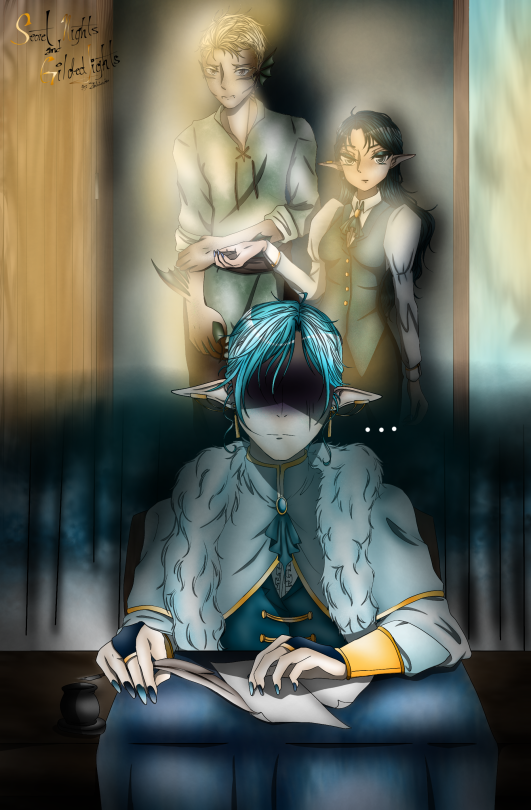
Hi! Your stories are amazing and it's what got me in the fandom! I actually drew one of the scenes of SN&GL: Chapter 2. Hope you like it! 😊Keep up the good work!
I AM SCREAMING THIS LOOKS SO PRETTY OP I AM GOING TO CRY
Tbh at first I thought this was Scott in the meeting having a flashback about Jimmy then I saw Zeva and my brain went !!!! OH OH THAT SCENE OHHH
I'm very flattered that my work inspired you enough to make art about it!! Honestly, as a writer, people drawing scenes from my fics(looking at you @daydreamdoodles<3) fills me with so much joy. It's surreal ro see other people's interpretation of your work!!!
That being said: ZEVA IN THIS OH MY GOD I AM FROTHING IN THE MOUTH JDBDJDJD SHE'S SO PRETTY I AM ASDLKGDW THE GRACE THE POISE THE PERMANENTLY UNAMUSED EXPRESSION I LOVE HER
I'm glad you enjoyed Sn&gl! That fic really has my entire soul in it and it's so cool to see other people interested!
#zan responds#it's home? home#empires smp#zan screams#GOSH THIS IS SO PRETTY I CAN'T EVEN#MAY I JUST MENTION THE A++++ COMPOSITION???#THE EXPRESSIONS?#JIMMY BEING ALL TIMID AND WORRIED#SCOTT BEING A MIXTURE OF “Oh god oh god” and “OH NO HE'S HOT”#ZEVA'S PERMANENT POKER FACE#the juxtaposition of the lighting#gosh I love tjem
14 notes
·
View notes
Text
youtube
Watch the American Climate Leadership Awards 2024 now: https://youtu.be/bWiW4Rp8vF0?feature=shared
The American Climate Leadership Awards 2024 broadcast recording is now available on ecoAmerica's YouTube channel for viewers to be inspired by active climate leaders. Watch to find out which finalist received the $50,000 grand prize! Hosted by Vanessa Hauc and featuring Bill McKibben and Katharine Hayhoe!
#ACLA24#ACLA24Leaders#youtube#youtube video#climate leaders#climate solutions#climate action#climate and environment#climate#climate change#climate and health#climate blog#climate justice#climate news#weather and climate#environmental news#environment#environmental awareness#environment and health#environmental#environmental issues#environmental justice#environment protection#environmental health#Youtube
16K notes
·
View notes
Text
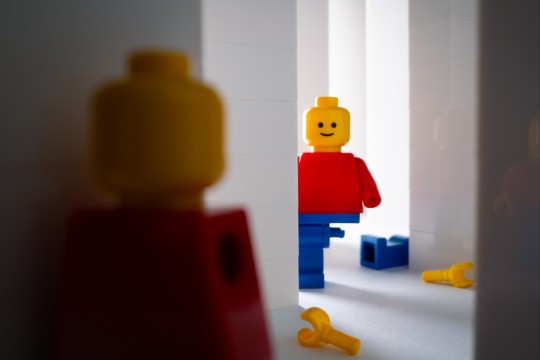
❤️ FEATURE: @johnreiley
For the first feature of this month of February I selected this photo of @johnreiley because it intrigued me a lot.
As you may know, I like photos that tell a story or those that leave room for interpretation by the observer. Here we are dealing with a photo that falls into the second category.
And that’s why it intrigued me because I asked myself why? Why is this “dismembered” figurine smiling? Why is she in the light while another seems to be hiding in the darkness. At first glance it gives off a feeling of sadness but in fact in my opinion it is positive. What do you think?
I also appreciate the use of very marked chiaroscuro to convey 2 emotions, 2 very distinct feelings. The well-marked vertical lines are relevant to draw our eyes a little more towards this smiling figurine.
John also explains :
"I had the goal to create a shot with minimal color that also played on juxtaposition of opposing themes. For example: a minifig that has been pulled apart but is still smiling at the camera; a bright white environment contrasting with an unsettling scene."
Thank you for this beautiful composition !
*For a chance to be featured, join our Discord and post your photo in the relevant section. THANKS*
@sarouxbastoux
33 notes
·
View notes
Note
Dude, I LOVE your style so much! The way you compose your art within circles a lot of the time is really cool, and your coloring is really evocative. Do you have any tips for someone still struggling a little with composition and color?
Thanks for these kind words!
My usual caveat before any generalised advice is to advise leaning in to whatever it is that makes you tick - so analysing what it is about colour choices and compositions that appeal to you (whether in art, packaging design, etc!)
(This goes for working digitally) With colour - using the hue/saturation/lightness tool really helped me understand it better! It can mean a lot more time spent tweaking them, but over time helps you build up an idea of what looks best more intuitively.
Feel like I often lean towards relatively centered compositions, despite enjoying really unconventional/off-kilter ones. I try to incorporate elements of that in my pieces - deliberately making things a bit 'off', or weird. Juxtaposition is pretty central to my practice, so I think I usually attempt to find a balance between something that looks both controlled and chaotic.
Hope this is helpful somehow/thanks for asking!
20 notes
·
View notes
Text
Tifa's Theme: A Musical Deep Dive (Part I)
(A repost from my old side blog no longer in use. All future analyses will be on this one.)

Greetings and welcome to our deep-dive into Uematsu-senpai’s masterpiece of a character theme. We will examine the rich marriage between composition and storytelling – ie. how its musical elements express Tifa’s personality, conflictions, relationships, and story motifs. If you’ve come with zero knowledge in music theory, then my hopes are that you will leave here somewhat enriched (no prior knowledge is required). If you are a fellow geek for music, then I hope this adds insight in a storytelling sense. Ultimately, the goal of this post is to more deeply understand Tifa Lockhart.

I have divided this analysis into five sections each built on the prior: (A) the key; (B) the intro; (C) the leitmotif; (D) the game’s use of the leitmotif; and (E) the compilation’s use of the leitmotif. (The leitmotif of course being Tifa’s recurring melody, of which the first subphrase is sampled above.) Because Tumblr allows only 5 videos per post, each section will be its own post, bar for the first two which will overlap in Posts I and II.
So have your headphones/audio ready, and let us commence.
Disclaimer: these are simply my own interpretations offered with supporting evidences. I can only, to my best limited efforts, speculate as to what Uematsu did or did not intend when composing the piece.

Section (A): The Key
Tifa’s Theme is composed in the key of F major, one of the happiest keys in music. It is argued by many, in fact, to be the happiest key (though this is subjective).
“F major is at once full of peace and joy…”
– Ernst Pauer (19th C. composer).
This is a reason, I presume, that Uematsu-san chose F major for the track which represents home.
“Welcome home, Cloud,” is the first line that Tifa speaks to Cloud in the game. “I’m home” (from the Japanese dub, 唯今 – “Tadaima”) is the last thing Cloud says to Tifa at the end of Advent Children. Home is our first story motif embodied by Tifa’s character.
But of course Uematsu’s decision likely only began there.
“F major is at once full of peace and joy, but also expresses effectively a light, passing regret – a mournful, but not a deeply sorrowful feeling.”
– Ernst Pauer (quote continued).
So we have peace and joy with an undertone of mournfulness; a juxtaposition between two opposing ends of the emotion spectrum. To appreciate how the key of F major achieves this, we can benefit from a quick comparison with two other tracks.
It might surprise you that Tifa’s Theme – our warm song of home – shares the very same key notes as the tensest and most sorrowful track in Final Fantasy VII. Listen to the Cries of the Planet is composed in F major’s relative minor key: D minor. It has the same key chords as F major, yet the chords serve different functions (something we will get to later). Put another way, it has all the same notes, yet they are arranged differently. Where F major is (argued) the happiest key in music, D minor is almost universally called the key of “true sorrow.”
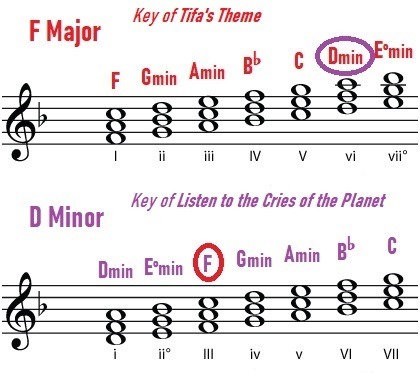
Let’s compare the two tracks here:
youtube
I wanted to begin with this little contrast for three reasons. First, to excite you non-music-theorists about the emotive power of music. Here, from our two related keys, come two completely contrasting moods. Second, we are concerned with what and how the notes will speak. Third, well… that’s a little more selfish. Listen to the Cries of the Planet is my favorite track in the game.
Our other track is the main section of One-Winged Angel (there are a total of three keys in this track.) It is curious that the foil character to Tifa has his theme in the relative minor of hers. Like a mirror – for as Sephiroth is Cloud’s darkness, Tifa is Cloud’s light. D minor is also the key from Those Chosen by the Planet.
youtube
And now, onto our deep-dive into Tifa’s Theme, which features in the original game, Advent Children, and 2020’s Remake. For now we’ll be using the piano sheets from Advent Children.
Section (B): The Intro
youtube
Tifa’s Theme begins with a tonic chord (the ‘home’ chord of our key). The further we move away from our tonic, the greater the tension (‘instability’) will be.
By ‘home’ here I am referring to the music’s tonal center – not ‘home’ the story motif which Tifa embodies. In light of that distinction, however, with the tonic being the home point of the track and home being a story motif central to Tifa’s character, we are simultaneously referring to both.
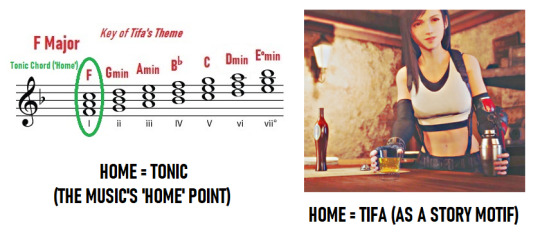
So we begin with our tonic (the F major chord) which draws us “at once [into] peace and joy.” Yet there is concurrently the hint of a mournful undertone. Only a tiny, tiny allusion – perfect for our introduction to Tifa. When we first meet her after all, we’ve no idea of the burdens locked in her heart.
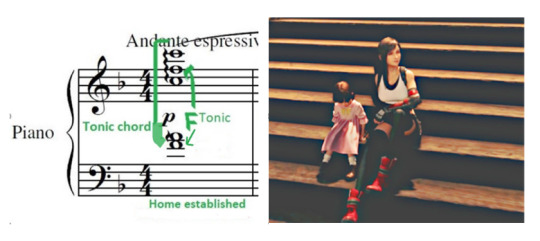
This opening tonic is presented in whole notes (the longest kind of note in common composition). In our piano version, these whole notes are arpeggiated (see the squiggly lines to their left), meaning that the chord is ‘spread’ or ‘rolled’ – the notes are played and held one after the other from the bottom up. We are at once drawn in by Tifa’s inviting warmth and we linger there.
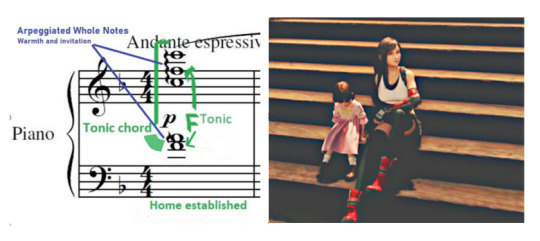
Our tonic is immediately succeeded by a chromatic chord (a chord composited of notes outside the key; notes that ‘don’t belong’). This second chord is, in fact, is the sort we would expect to find in F minor. It does not ‘belong’ in our key of F major – thus the mournful undertone which would have been further hinted is brought into direct statement. Foreshadowed is the revelation of Tifa’s burdens. She is carrying deep and unsettling secrets.

How does this work? Uematsu-san has effectively ‘borrowed’ the second chord of the F minor key and inserted it into the track’s opening chord progression. This subverts the natural expectation of our ears and creates instability – a trick he will frequently pull to toy with our emotions.

Uematsu-san then extended this borrowed chord to heighten the mournfulness by adding a 7th (a note seven intervals above the root note which further colors the mood). This enlarges the magnitude of Tifa’s mournfulness: we feel that her burdens are heavy.

The next two bars instantly carry us back to the tonic (see the harmony on the bottom stave below). This occurs in a slow fall, a faster fall, then a faster, now extended lift: the intro’s re-establishment and emphasis on the motif of home. We are never to stray from feeling at home when we are around Tifa. Simultaneously, these bars speak the ‘locking away’ of Tifa’s burdens. Her sufferings are buried quickly as her love for others is brought to the forefront.
Where our chromatic chord had an added 7th to heighten the mournfulness, our tonic build is extended with a 7th and 9ths in its lift – heightening home in a stronger comparative sense. Tifa being a home to others, in other words, overpowers her own sufferings.

There are three things we can grasp from this sequence of slow-fall to faster-fall to faster-extended-lift.
First, Tifa holds a profound motherliness toward others which outweighs thought for her own wellbeing.
Second, Tifa is insecure in dealing with her emotions, and thus strives to keep herself distracted from them. We will see this displayed right from the time of her childhood:
At 8, unable to cope with her mother’s death, she treks up the perilous mountain to try and ‘find her’ on the other side;
At 15, unwilling to face the grief of her father’s murder, she recklessly rushes to confront Sephiroth;
At 17 (in Traces of Two Pasts), she confesses to Jessie that she has been “running” from learning the truth about Nibelheim;
At 20 (in Remake), she admits she’s not even allowed herself time to decorate her apartment;
At 22 (in On the Way to a Smile), she avoids being alone in keeping extra busy with the bar and the kids during Cloud’s absence.
Thirdly – and perhaps most jarringly – Tifa embodies home despite her life being plagued by suffering.
Tifa, who lost her home and had to rebuild her life from scratch, provides a home for Cloud, Marlene and Barret, Avalanche, and later, Denzel.
Tifa, who lost her mother as a child, mothers everyone else, is for all intent Marlene’s mother, and becomes the mother of a family unit with Cloud, raising two kids who are not her own.
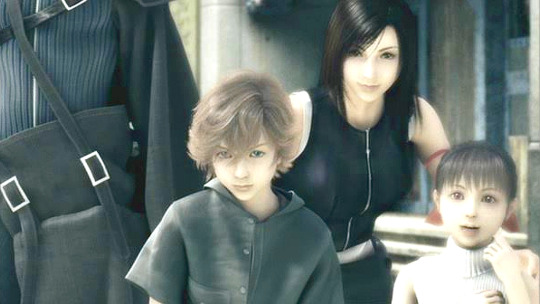
We have now travelled through the first subphrase of the intro.

youtube
We begin Subphrase Two with our opening tonic again, but this time in a quite surprising extension. Rather than adding a happy 7th or 9th to accentuate the warmth of our home chord, Uematsu-san gives us an E note which clashes with our F. Moreover, he builds the chord from this E as the bass (bottom) note.
What does this mean? Dissonance. Home is re-emphasized, but now directly with mournfulness. Although Tifa’s burdens are locked in her heart, they are ever lingering in the picture.

Compare this tonic (with the clashing E) to our opening tonic in Subphrase One. We now also have an additional climb in the harmony, which includes an added 9th. So while we can more deeply sense Tifa’s mysterious burdens (even though she’s our place of peace), extra emphasis is placed on her warmth and motherliness.
Subphrase One opening vs. Subphrase Two opening:

And so we continue Subphrase Two, following the pattern from Subphrase One. A chromatic chord follows the tonic – again ‘borrowed’ from the key of F minor – bringing Tifa’s plights to bubble once again. But before we can linger on them, we are taken back to an extended tonic chord – this time with an ‘unbelonging’ note.
From the next bar, however, things begin to shift…

Before moving onto this shift, let’s consider what we’ve covered so far. We began “at once full of peace and joy” (Tifa’s warmth pulled us toward her, pulled us home), to be immediately carried into an expression of suffering (Tifa’s secret, unsettling burdens were glimpsed). That suffering was overpowered – but not entirely suppressed – by a magnified emphasis of home (Tifa locked her burdens away behind her nurturing kindness). The suffering surfaced briefly again, and again home was accentuated (Tifa’s endless heartache continues, beneath the bounds of her love).
As is very clear by now, Tifa is facing great internal conflictions. Let us dig into what the music so far has conveyed of those conflictions.
Spoken in long-value notes, our Subphrase One melodic chords convey Tifa’s hesitance in expressing her burdens. That they shift and waver between tonic and chromatic conveys her uncertainty.
Subphrase One conveying hesitance (in long-value notes):

Subphrase One conveying uncertainty (tonic > chromatic > tonic):

Tifa is longing to confront Cloud with the truth of his psyche. At the same time, she is uncertain of both what that will bring and what the truth is: she fears losing Cloud; and she doubts the validity of her own memories from the events he is recounting so accurately. These hesitancies, fears and doubts are gnawing at her heart, buried from the rest of the world under the forefront of home.
Subphrase Two contains less long-value notes and more wavering than Subphrase One, building the intensity of Tifa’s conflicts clashing within her. Rather than wavering from tonic to chromatic to tonic, we go from a dissonant tonic to a chromatic chord to a tonic with chromaticism to more tension in a predominant chord. I’ll get to what this means in the next post, but for now, just know it is a chord of instability.
Subphrase Two (less the final bar) building instability:

Following our new tension chord (the predominant G minor in blue) we have just one bar left to end the phrase. As it is the end of the intro as a whole, we expect to return to the tonic. But (bless Uematsu and his subversions)… the opposite happens.
Our ears expect resolution, but we are instead dragged right into the highest point of tension. Here, we are pulled into the world of the dominant chord.
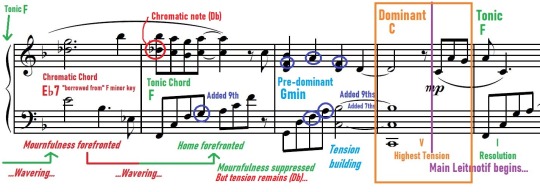
Continued in Part II here.
#final fantasy#final fantasy vii#final fantasy 7#ffvii#ff7#advent children#nobuo uematsu#tifa lockhart#cloud strife#sephiroth#avalanche#cloud x tifa#cloti#music analysis#character analysis#my deep dives
23 notes
·
View notes
Text

THE ARTIST’s DREAM | 1900 | by EMIL HOLÁREK
The painting is a captivating exploration of the artist's subconscious mind and creative psyche. It reflects the broader artistic and intellectual movements of the turn of the century, particularly the burgeoning interest in psychology and the unconscious.
The composition is complex, with layers of symbolism and surreal imagery that invite interpretation. At the center of the painting stands the artist himself, depicted in a state of deep contemplation. His gaze is introspective, suggesting a journey into the depths of his own psyche.
Surrounding the central figure are a plethora of symbolic elements that hint at the inner workings of the artist's mind. Strange creatures, fantastical landscapes, and enigmatic symbols populate the canvas, creating a sense of otherworldly wonder. Each element seems to hold a deeper meaning.
One notable aspect is its exploration of the subconscious and the role of dreams in the creative process. By delving into the realm of dreams, HOLÁREK taps into a source of inspiration that transcends rational thought. The painting suggests that the artist's most profound insights and innovative ideas may arise from the depths of his unconscious mind.
The use of symbolism is particularly potent in this work. From the presence of celestial bodies to the juxtaposition of light and shadow, each element contributes to the overall narrative of the painting. Through these symbols, HOLÁREK communicates themes of creativity, spirituality, and the mysteries of human existence.
In conclusion, "ARTIST’s DREAM" is a masterful exploration of the subconscious mind and the creative process. Through its intricate composition and symbolic imagery, EMIL HOLÁREK invites viewers to embark on a journey into the depths of the artist's imagination.
#the artists dream#emil holarek#realism#cubism#surrealism movement#surrealart#surrealist art#surreal#surrealism
4 notes
·
View notes
Text
youtube
Watch the 2024 American Climate Leadership Awards for High School Students now: https://youtu.be/5C-bb9PoRLc
The recording is now available on ecoAmerica's YouTube channel for viewers to be inspired by student climate leaders! Join Aishah-Nyeta Brown & Jerome Foster II and be inspired by student climate leaders as we recognize the High School Student finalists. Watch now to find out which student received the $25,000 grand prize and top recognition!
#ACLA24#ACLA24HighSchoolStudents#youtube#youtube video#climate leaders#climate solutions#climate action#climate and environment#climate#climate change#climate and health#climate blog#climate justice#climate news#weather and climate#environmental news#environment#environmental awareness#environment and health#environmental#environmental issues#environmental education#environmental justice#environmental protection#environmental health#high school students#high school#youth#youth of america#school
16K notes
·
View notes
Text
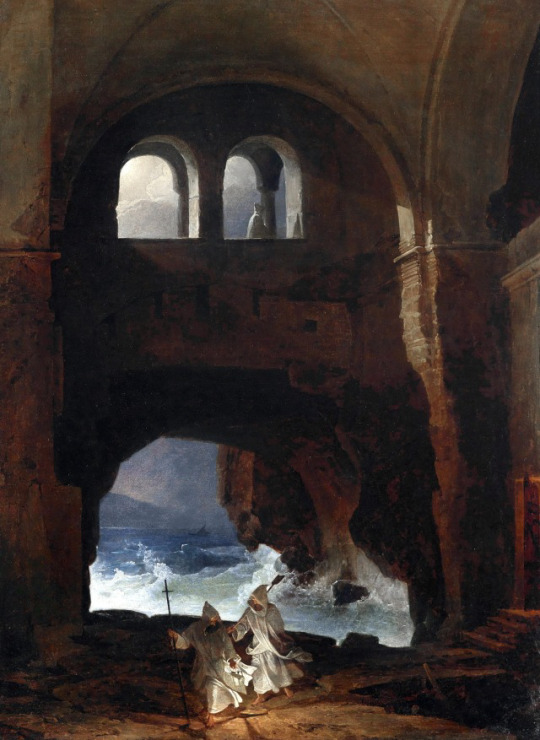
“Mönche im Hof eines Klosters am Meer”
by Franz Ludwig Catel
Oil on Canvas, height: 77 cm (30.3 in); width: 58.5 cm (23 in)

Technique:
Catel is highly meticulous in his treatment of light and shadow, a characteristic feature in most of his works, including this one. His application of chiaroscuro is subtle, yet powerful, balancing the dark shades of the monastic robes with the brightness of the open sky and the glimmering sea in the background. This serves not only an aesthetic purpose but also a symbolic one, emphasizing the contrasting worlds of spiritual contemplation and the boundless freedom of nature.
The artist’s use of perspective is also worth noting. In "Mönche im Hof eines Klosters am Meer," the viewer’s eye is guided by architectural elements of the monastery which frame the monks and lead the gaze toward the sea and sky beyond. This induces a sense of depth and volume, lending a three-dimensional quality to the flat canvas. The foreground and background appear to be in conversation, highlighting the liminal space that the monks occupy—between the walls of spiritual commitment and the expansive, untamed nature outside.
Paint Application and Color Palette
Catel's application of paint is calculated but not overly detailed, a methodology that places him somewhere between the idealized depictions of Romantic landscapes and the gritty realism that would come to define later movements. He employs a restrained color palette, avoiding excessively vivid hues in favor of more muted, natural tones that contribute to the overall tranquility and meditative mood of the painting. The muted browns, grays, and blues harmonize with occasional brighter colors to create a sense of balance and unity in the composition.
Chiaroscuro
While not as dramatically applied as in Tenebrist works, Catel uses chiaroscuro to create depth and volume in both the human figures and architectural elements. The interplay between light and shadow brings out the nuances of the physical forms and contributes to the atmosphere.
Atmospheric Perspective
Catel employs atmospheric perspective to create a sense of depth and distance, particularly noticeable in the transition from the monastery to the sea and sky. Colors and details gradually fade as they recede into the distance, mimicking the effects of the atmosphere on distant objects.
Linear Perspective
The use of linear perspective is evident in the architectural details of the monastery, guiding the viewer's eye through the painting and adding to its three-dimensionality. The lines converge toward a vanishing point, enhancing the sense of depth.
Color Harmony
Catel uses a carefully curated palette of muted colors that work in harmony, such as earth tones and subdued blues. This harmonious color selection adds to the serene, contemplative mood of the painting.
Realistic Proportions
Catel employs realistic proportions for human figures and architectural elements. This adds a sense of authenticity to the painting and makes it easier for the viewer to engage with the scene.
Texture Variation
Although it's hard to discern without closely examining the original painting, Catel likely used varying brushstrokes to create different textures for different elements, such as the fabric of the monks' robes versus the stonework of the monastery or the water in the background.
Soft Transitions
Unlike Tenebrist works where sharp contrasts are common, Catel employs softer transitions between light and dark areas, as well as between different elements of the painting. This technique contributes to the painting’s overall tranquility.
Focal Points
While avoiding the dramatic focal points often found in Tenebrist and Baroque works, Catel subtly guides the viewer’s attention through the painting using compositional balance, the arrangement of figures, and the framing created by the architecture.
Subtle Symbolism
The juxtaposition of monks against the backdrop of the sea, as well as the interplay between the confined space of the monastery and the expansive ocean, suggests a contemplative theme. While not a painting technique per se, this method of conveying meaning is worth noting as part of Catel's overall approach.
Layering
It's likely that Catel employed layering to build up color and texture, a common practice in oil painting. This would allow him to achieve the subtleties in tone and hue that are visible in the work.
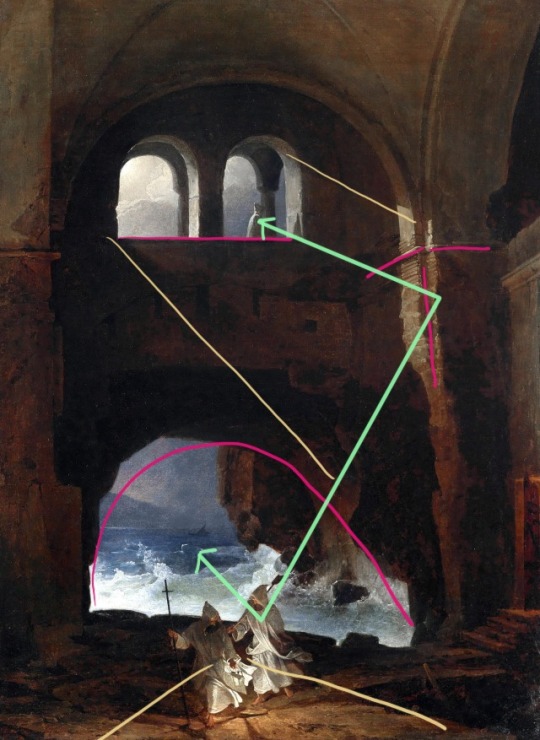
The above image is what I used for my analysis. The green line shows the dominant directions that the eye moves across the work, which is reinforced by the light source, the positive and negative spaces, and the interplay between geometric and organic lines.
Medium Composition
Given the time period, location, and mediums used in Franz Ludwig Catel's work, it's likely that the artist employed traditional materials commonly used in early 19th-century European oil painting. Linseed oil would have been the primary binder for oil paints, as it was widely accessible and had been extensively tested and favored by artists for its versatility and durability. It has a propensity for forming a robust, transparent film that adheres well to canvas, allowing layers of pigment to retain their hue over time.
Other possible binders might include poppyseed oil and walnut oil. These oils dry more slowly and are less prone to yellowing than linseed oil, though they were often more expensive or less readily available. Additionally, they are less flexible than linseed oil, making them less suited for use on canvas but potentially beneficial for panel paintings.
As for varnishes, natural resin varnishes, like damar or mastic, could have been applied to protect the finished painting. These varnishes are organic substances secreted by trees and were commonly used for their clarity, ease of application, and ability to saturate colors, making them appear more vivid. However, they are prone to yellowing and becoming brittle over time.
Artists in the 19th century were also starting to experiment with synthetic varnishes, though their application was not as widespread as natural resins. Shellac could also have been an option, albeit less commonly used for oil paintings due to its high alcohol content and propensity to discolor. Some artists, following the Venetian technique, sometimes used a final layer of wax to saturate colors and protect the artwork.
I could not find any history of prior restorations for this painting, so determinations of mediums and varnishes is purely speculative.

Artist:
Born in Berlin in 1778, Franz Ludwig Catel initially embarked on an artistic journey through wood carving and book illustrations, creating plates for literary works like Goethe's "Hermann and Dorothea" in 1799. His artistic acumen expanded as he delved into Indian ink and watercolors, culminating in a 1806 piece entitled "The Death of Nicholas of Bernau," which earned him entry into the Berlin Academy. His repertoire extended further after a sojourn in Paris in 1807, where he honed his skills in oil painting.
By 1812, Catel had reached Rome, significantly enhancing his artistic education through associations with influential figures like Koch, Overbeck, Schadow, and Cornelius. Specializing in landscapes punctuated by architectural or human elements, Catel soon gravitated towards a neoclassical approach in landscape painting. His works notably accentuated the principles of perspective, as well as the nuanced interplay of light and shade. A trip to Sicily in 1818 alongside Prince Golitsuin added an expansive dimension to his artistic vision.
Catel, along with his contemporaries like Granet, focuses less on overt religious imagery and more on the practice of religion within serene environments. Their works, like this one, evoke emotions of piety and spiritual reverence. The setting within the Gothic cloister—a relic of the medieval period and a favorite among Romantic artists and writers—invokes a sense of melancholic nostalgia, also observed in the works of contemporaries like Friedrich.
Enjoying the munificence of Elizabeth, the widow of the 5th Duke of Devonshire, Catel found himself in an advantageous position. Elizabeth, who moved to Rome after her husband's demise, facilitated a vibrant artistic and literary milieu, backing projects such as archaeological excavations and publishing classical texts. Born to a father who was an art aficionado, Elizabeth had been surrounded by ancient monuments throughout her life. It was, therefore, no anomaly that she felt drawn to Rome, where she became a magnanimous patron of the arts, surrounding herself with works from renowned artists including Catel. After her death in 1824, a French embassy secretary in Rome aptly acknowledged her indelible impact on the arts, stating that she had swiftly developed a taste for art, attracting eminent artists to her salon and filling it with their creations.
Sources:

Historical Context:
Between 1850 and 1860, Berlin was a nexus of multifaceted transitions, caught between the ever-changing dynamics of sociopolitical forces, economic developments, religious influences, and cultural shifts. Located in the Kingdom of Prussia, Berlin was not only its capital but also its pulsating heart, epitomizing the very essence of the ongoing transformations that were pivotal in shaping modern Germany.
Sociopolitical Climate
Politically, this decade was a period of flux, characterized by the struggle between conservative monarchist forces and a burgeoning liberal movement. The failure of the Revolutions of 1848 had forced many liberals into a state of quiescence, but their ideals did not dissipate. Political discourse was dominated by issues such as constitutional governance, civil rights, and national unification under a liberal regime. Despite the conservatism of the Prussian monarchy and aristocracy, there were ongoing attempts to incrementally modernize the Prussian state, often impelled by the pragmatism of economic necessity rather than ideological evolution. The government’s wavering position was reflected in policies like the “New Era” which was initiated by King Frederick William IV. This policy was an attempt to placate liberal demands for reform without relinquishing absolute royal authority.
Economic Climate
Economically, Berlin was an expanding urban center. The advent of industrialization had a considerable impact on the city’s labor and trade. Textile mills, metal works, and chemical plants contributed to urban employment, thus attracting migration from rural areas. The role of financial institutions like banks also became increasingly significant, acting as the bedrock of industrial financing. Economic expansion, however, was not uniformly advantageous. While it enabled the burgeoning of a middle class, it exacerbated income inequalities and introduced the social question, the so-called "soziale Frage," into the political discourse, centering on the living conditions of the urban proletariat. Economic considerations were also a driving force behind Prussia's leadership in the formation of the Zollverein, a customs union that was pivotal for future unification.
Religious Climate
Berlin's religious landscape was predominantly Protestant, given Prussia’s Lutheran history. However, it was a period of religious diversity and change. The Jewish community was gradually becoming more integrated, notwithstanding the societal anti-Semitism that persisted. The Haskalah, or Jewish Enlightenment, was active in Berlin, advocating for modern education and integration into German culture while preserving Jewish traditions. Moreover, the critical examination of religious texts became more common among scholars, sowing seeds for the later demythologization of religious narratives. The church maintained its political influence, often aligning with conservative elements within the society, yet it was increasingly coming under the scrutiny of rationalist thought and secular governance models.
Cultural Climate
Culturally, Berlin was evolving into an intellectual and artistic hub. The influence of Romanticism began to wane, giving way to Realism in arts and Biedermeier in interior design and architecture. Intellectual salons hosted discussions on philosophy, politics, and the sciences, frequently serving as conduits for liberal ideas. Universities were not merely academic institutions but centers of political thought. The field of historiography gained prominence, partially influenced by Leopold von Ranke, who stressed the importance of empirical methods in historical study.
Impact on Daily Lives
Various events and developments had a palpable impact on everyday life in Berlin. The construction of railways, for instance, revolutionized transportation, facilitating the movement of goods and people, but also contributing to the urban sprawl. Similarly, advances in medical science led to the dissemination of vaccines, notably affecting public health. Furthermore, the rise of newspapers and journals increased public engagement in political and cultural dialogues, making information more accessible.
The decade was also punctuated by public gatherings and demonstrations, which were met with varying degrees of government repression. Such events were both a reflection of the political aspirations of the populace and an ongoing cause of social tension. Given that Berlin was home to the royal family and the Prussian political establishment, governmental decisions, whether concerning foreign policy or internal administration, reverberated through the city both psychologically and materially.

Personal Notes :
This painting stood out to me immediately due to its portrayal of equal parts intense movement and serene stillness. I can feel the night ocean wind billowing through the bay. The sound of the waves permeates the stone of the monastery. The air is dressed with mystery and a sense of spiritual contentedness. The stones are monoliths of silent persistence, while the arches are a softening of the harshness of the wind. Mist brushes across the skin, the smell of salt. Echoes of a hushed conversation breaks just over the sound of the water.
This artist was introduced to me through a post by @aqua-regia009
(They will likely be tagged a lot in my posts, I highly recommend following them.)
13 notes
·
View notes
Text
Beatles for Sale (1964)
What happens when you've used up an album's worth of original compositions and your schedule has been absolutely jam packed? If you're this band, ya release another album, naturally!

I'm a sucker for the Autumnal Aesthetic but these lads were not having a jolly time amongst gilded leaves! Featuring George's hair at peak Onion.
This one is infamously very Cover heavy, but does that really make it one of the weakest instalments? I've liked some'a their covers a lot, though the originals often outrank them with good reason. Let's see how the mixture here fares~
SIDE ONE
No Reply: It may reference that archaic device known to older people as a Telephone, but this number is shockingly timeless all the same! A jaunty song about a relationship that has either fizzled out, or the POV character has been cucked without a formal breakup. Even though it is about ghosting and resentment, it's got a great rhythm and energy to it, plus I'm also very fond of the "Your Face" version from the Anthology uploads.
I'm a Loser: Another oddly catchy song given the introspection and distinctly downbeat subject. There's something about how fun the music becomes at the chorus, peak juxtaposition~ Harmonica makes a bold return, too! It's one of the most dance-able depression songs so far!
Baby's in Black: A clear narrative is stated here, of the Singer lamenting that the object of his affections is busy grieving over someone else. I get the impression that the mourning is in fact literal, that the other beau is dead and buried, and that we ain't s'posed to side with the Main Character for being a self-centred berk about it (but some of the AHDN songs plant a seed of doubt for the Irony take, given how there's spite and selfishness in those...!). Anyway, the song itself is serviceable but not as notable as the prev numbers.
Rock and Roll Music: Ah, our first cover! It's good and well played but I don't think our lads really bring anything to the table that the Chuck Berry didn't already provide. I listened to that right after and neither version lights a fire in me.
I'll Follow the Sun: This has a very nice, mellow sound to it, but it has a bit of the snag I found on AHDN's 2nd side; that it seems to be a "You're gonna regret this" song. The reoccurring "But Tomorrow may rain, so I'll follow the Sun" sounds optimistic and hopeful but when it's surrounded by the passive aggressive sentiment... I will say it's possible I've got the wrong end of the stick [The prev album was an Experience lmao], but it does seem telling that this original number is like, never Iconic lol
Mr. Moonlight: MISTAAAAAAHHHHHH. Another cover but idk the original. Sounds a little more gay than normal, if they're gonna personify The Moon as a guy and declare their love for him :v
Kansas City / Hey Hey Hey Hey: I have a slight dislike of this just cause it took me longer to write the title out. So it's a cover, but of 2 songs mashed together? Paul is bringing his impression of a deeper voice and the instrumentation is very nice but eehhhh. It's not one I'm gonna go back to lmao
SIDE TWO
8 Days a Week: Finally some good fucking food!! A much needed injection of cheer, and while it seems the Bugs themselves didn't think that much of it sometimes a simple sweet song is a nice thing to boogie to.
Words of Love: Ah, Buddy Holly? Their idol and main reason for the Beatle moniker? Seems to be a decent cover of one of his numbers, while there ain't many lyrics the guitar and drums are very nice, though I could do without the clapping.
Honey Don't: Ringo's vocal return since With The Beatles! This song doesn't do much for me but the little flourishes thrown in like "Rock on George, for Ringo one time!" and fab guitar work have me smiling~
Every Little Thing: Annoyingly my brain keeps autofilling 'she does is magic' and then I find it harder to remember how this one sounds. But it's actually a stronger song on this here album, another Actually Pleasant one! The timpani has such a dramatic presence but for once I'm not concerned about the girl's safety like I am in other ones lmao
I Don't Want to Spoil the Party: This sad song is set to another jaunty rhythm that kicks into a higher gear for the bridge... hmm, seems to be the main thesis of this album, innit! Kudos for this POV feller to at least try being a bit more self aware. This ends a little bit abruptly, which makes it another shade different to I'm A Loser.
What You're Doing: "Oh babe you've crossed me and I'm gonna make a big deal about it in song form" song. I've heard lotsa these on this and the prev album!! But while I'm repeating the same sentiments about them doing that, I looove the guitar and drum work on this very mid lyrical assortment.
Everybody's Trying to be My Baby: Another tedious title! Another cover, too. George's only vocal on this one and I don't think it's great. I do like Rock and or Roll but the ones this album uses don't make a strong impression on me. Guitar good.
CONCLUSION
Best 3: No Reply, I'm a Loser, 8 Days a Week
Blurst 3: Kansas City/Hey [x4], What You're Doing, Everybody's [...] Baby
Overall Quality?: It took the 2nd side of the record for the first original song on the album to be energetic and sincere without slightly concealed bad vibes! That's pretty dang indicative of what the Burnout Album has to offer. There's a fair bit of mildly good Rock 'n' Roll, lotsa great instrument playing, but man oh man this isn't a Good Time Had By All.
But I must make clear that the good songs, are great! And some of the miseryfests are still catchy lol. Before I listened to all the songs I was ready to bat for this being an underrated gem, but hmmm, no actually it is a weak one. But I can give them the benefit of Early[ish] Day Feet Finding + HUGE MASSIVE PRESSURE being why it's a bit on the limp side. I felt more disappointed in A Hard Day's Night side 2 than with this, though my "C'mon dudes" reasoning is pretty much the same, and this has more Mid Covers.
🪲🪲🪲🪲
Well, after an underwhelming release like that and yet their fame continues to balloon bigger and bigger, would it be fair to say the Beatles needed Help!? ;3c
#The Beatles#Beatles for Sale#CutCat listens to Bug Music#Music Review#Not an April Fool's post#I like posting these on the 1st of each month!#I'm looking forward to Help! though I know some'a that is favoured by how much I like their stupid ass stoner flick lmao#I am not beating the Cover Hater allegations but I adore one that is coming up on Help! ^w^
5 notes
·
View notes
Text
Religion ( or just me babbling, it gets off track:)
Religion
In the early days of humans, they had gods. From the very beginning of time. It meant to people what they wanted it to. It was unique to each culture but there just the same.
But in my opinion, why follow one unified religion? I want something to believe in, to give me hope. Something sacred to me. But what does that for me is different from the world. So, here I go, here is my religion. My religion is the forest, the rough tree bark, and my fingers tracing the labyrinthine engravings as I sit on the branch, the sun brushing its fingers across my cheeks. My religion is the soft pink flush of our palms intertwined as we walk, pure, innocent, untainted. my religion is the soft yellow lighting kissing every surface of my room, from the piles of clothes on my floor to the covers on my bed to the shelves carrying my numerous notebooks journals, and sketchbooks
my religion is the rain, crystal beads falling from the heavens, compiling into puddles, miniature oceans pleading for you to come splash and splatter your skirt
my religion is creating, and being consumed with a purpose, passionate brushstroke, furious typing, careful sketching, lyrics, compositions, and concepts crowding my mind. My religion is peace, solitude, and introspection, those stolen ephemeral moments spent alone, and just being, or coming up with my own philosophies, and theories concerning my behaviors, tendencies, and character. My religion is girlhood. Or at least the way I view it. It is a visceral, cunning thing, and yet so beautiful. The juxtaposition of the diaphanous haze that clouds it, and the sharp, cutting experiences. From yearning for the moon, and to howl wildly under it, to collecting shimmering trinkets, and making everything pleasant. But there's also the other aspect. How the anguish and pain writhe inside me, wanting it to crawl up my throat and tumble out of my mouth, a scream bursting from my lips. Longing to be cherished and loved as a whole complete person, not an object of pleasure. But trying to cover it up with concealer, ribbons, and kindness. In the end, how you can cover up your skin and your hair, and all of your self-proclaimed hideousness, but you can’t cover who you are. You can’t stamp down your soul, at least not without losing it.
And my religion is my childhood. How it was so exceptionally lovely and enlightened. Yet at the same time dark, misunderstood, and shattered. How one day my mother would be making me a beautiful birthday cake, and the next dragging me down the stairs, as I stumble tears blurring my vision, spilling over my face. How one day my father would be watching a movie with me, and the next yelling in my face, and shaking my shoulders. They didn’t know how to handle me. And my child self thought that I was a monster. That there was one inside me and it would one day claw open the soft skin of my stomach and burst out of me, leaving the “sweet version” as my parents called it, an empty shell. And I would claw at my face, screaming that I hated myself. But I also played with my sisters, making up stories of fairy dust and rose petals, aliens, and goblins. And we would walk downtown to buy ice cream and go on hikes in the forest. my religion is everything that makes up me. it is the very essence of my being.
2 notes
·
View notes
Photo
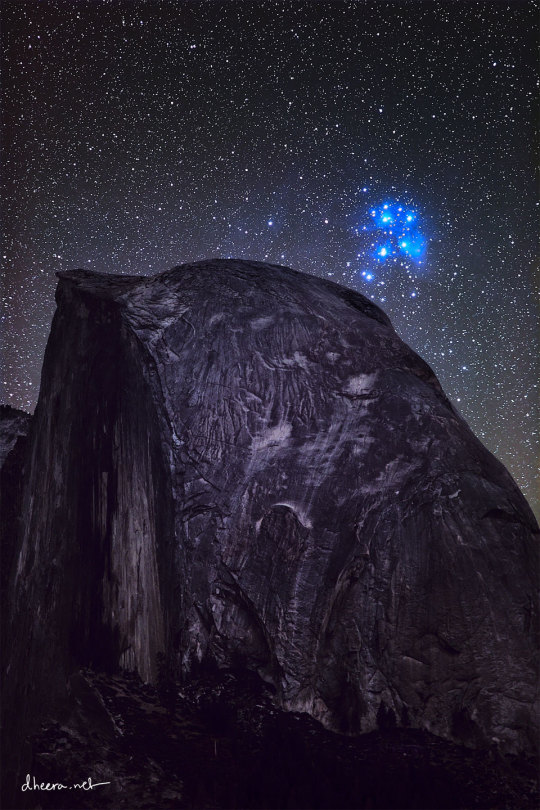
2022 July 19
Pleiades over Half Dome
Image Credit & Copyright: Dheera Venkatraman
Explanation: Stars come in bunches. The most famous bunch of stars on the sky is the Pleiades, a bright cluster that can be easily seen with the unaided eye. The Pleiades lies only about 450 light years away, formed about 100 million years ago, and will likely last about another 250 million years. Our Sun was likely born in a star cluster, but now, being about 4.5 billion years old, its stellar birth companions have long since dispersed. The Pleiades star cluster is pictured over Half Dome, a famous rock structure in Yosemite National Park in California, USA. The featured image is a composite of 28 foreground exposures and 174 images of the stellar background, all taken from the same location and by the same camera on the same night in October 2019. After calculating the timing of a future juxtaposition of the Pleiades and Half Dome, the astrophotrographer was unexpectedly rewarded by an electrical blackout, making the background sky unusually dark.
∞ Source: apod.nasa.gov/apod/ap220719.html
93 notes
·
View notes
Photo
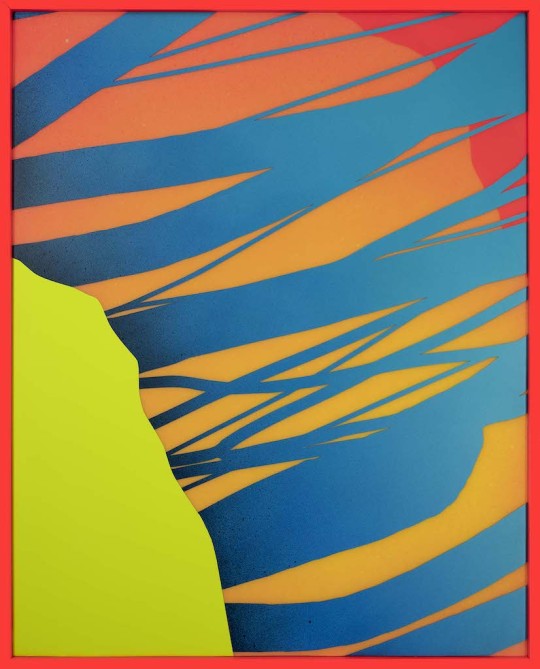






Rachel Strum’s “Interference.”
Opening on July 23rd, 2022 at Hashimoto Contemporary in New York City is artist Rachel Strum’s solo exhibition, “Interference.”
“Interference” showcases abstract paintings and sculptures that transcend the limitations of time and space. With the interplay of materiality through oscillating depths of color and substrates, organic and geometric forms commingle within flat and luminous layered and glittering surfaces in this new body of work. The forms mesh and collide simultaneously using a high-key color palette within and outside the confines of the picture plane. This striking juxtaposition creates tension and harmony between the natural and artificial, the familiar and the unknown.
Beyond dynamic compositions and punchy color combinations, there is also a softness from stretches of velvety-matte surfaces. The works feel boundless; how deep and far back in space do they extend? Are these cropped snippets from larger expanses? And although informed by more traditional formalist and hard-edge abstraction, the work extends beyond the two-dimensional surface and expands beyond it.
Brightly colored sculptures are displayed alongside the paintings. Using sculpture as a tool to explore space and time, pigmented resin poured in layers forms an object that emanates a glow from light passing through and reflecting. The layering requires the viewer to move around the work to capture the entirety of what is available to perceive.

BUY PRINTS | FOLLOW ON INSTAGRAM
72 notes
·
View notes
Text

"Patterns in The Umbra" by Tengushee captures the eye with its stark monochromatic simplicity and a deep exploration into texture and contrast. The artist employs a minimalist approach to convey a narrative, where the central swirl of white against the shadowed background creates a dynamic focal point.
There is an intriguing play between the light and dark elements within this piece. The title suggests an investigation of the shadow ('umbra') and the patterns that emerge within or from it. The splattered pattern on the surface adds an organic feel to the composition, while the clean lines of the square frame contain and define the chaos within it, perhaps reflecting on the boundaries we impose on the natural randomness of life.
The use of black and white intensifies the drama of the piece, inviting the viewer to ponder the juxtapositions it presents: order and chaos, light and shadow, creation and void. The droplet-like shapes give an impression of movement, frozen in time, each telling its own story within the same frame. This duality is further emphasized by the creamy viscosity of the white against the deep abyss of the black, symbolizing the tangible and the obscure.
Tengushee's creation is both an aesthetic experience and a cerebral one. It offers accessibility through its visual impact and traditional artistry through its emotional depth and intellectual engagement. This piece wouldn't be out of place in a gallery of modern art, evoking a contemplation that is as timeless as the interplay of shadows and light.
Find out more about the artists here:
2 notes
·
View notes
Text
Chapter 1050 — Honor
And the conclusion! Finally!
German’s Cold Blooded Voyage is great, really enjoying Anana

And then.
The conclusion.

A touch of Star Wars’ “let’s drop them in a pit of death” going on, but illustrated with a lovely section drawing.
I like the shifting from black and grey to the more contrasting and illuminating white glow of the underworld as Kaido breaks through the Earth.
However, those chutes cracking up from Law’s pit of death don’t look too good, leading all that heat up to the sea.

Two things about this page.
First, I really like the symmetry of Kaido and Luffy. There’s the neat layout of the text panels, with the revision of the earlier statement that Kaido won. Both have fought to their limit and are on the threshold of death: one will pass it and the other will keep on living. Kaido is drawn in stark contrast, with heavy whites and greys and blacks, while Luffy is drawn bruised and unconscious, yes, but with the same light lines he’s usually depicted with.
Second, there’s the whole juxtaposition of the Flower Capital. They have been celebrating the one night of the year they can; their breather of freedom. They have no idea what’s been happening in the skies above, but mere hopes and whispers of rumours; “did you hear that there’s a raid on Onigashima tonight?”
Onigashima still towers over it, but so does Momo. Momo’s dragon coils rise to the top of the palace in the city, showing how he’s grown and how he now can protect it: he’s big enough, both physically and mentally (in this moment at least; he’s still an eight year old brat at heart).

Damn you Oda for making me cry, again, for Yasuie.

And all the happy people! They’ve won!
I wonder what Apoo’s fate will be. He betrayed them but was then betrayed himself and then fought with Drake against CP0….who knows.
And where is Drake? I hope he makes it.
Speaking of…

Not looking good for a whole bunch of people. Poor Chopper, getting so overwhelmed his eyes turn to spirals :(
Going slightly in the wrong order here due to narrative, but I just really like the composition of these panels:

They depict two completely different places in the castle, but are still clearly showing the general victorious mood. Of course, the noise in the background is the visual thread, but the grey shading on Hyogoro and Komachiyo helps glue them together as well. Furthermore, the poses, obviously, are all the same with the exception of Mr Cool Pineapple over there — but even he and Hyogoro, the old foxes who’ve seen a battle or two, have the same pose and face!
And the battle is definitely over.
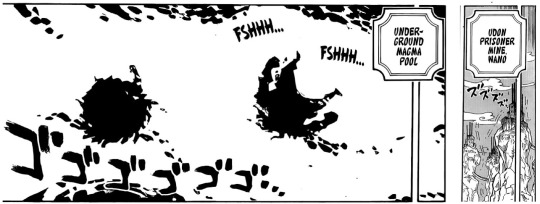
Pool of Magma? Well, a more certain death than Chasm of Death on the Deathstar.
Great contrast in the panel, horrible visual.
And nice how the tangible leftovers of Kaido’s reign are trembling! His time really is over.

And speaking of, this whole page is great.
You have a teeny, tiny Zunesha in the corner there, to show just how humongous the explosion is. You have a gentle smile on Luffy’s face: he can rest now.
And the great introduction of Momo to the citizens of Wano!
Remember, this is how the night was supposed to end in Kaido’s original plan. Onigashima, crashing down and a great dragon in the skies, crushing their one moment of freedom under the yoke of New Onigashima.

And of course, the living ghosts who again walk this Earth.
Great chapter!
I give it a star for storytelling and a high-five for art.
45 notes
·
View notes
Text
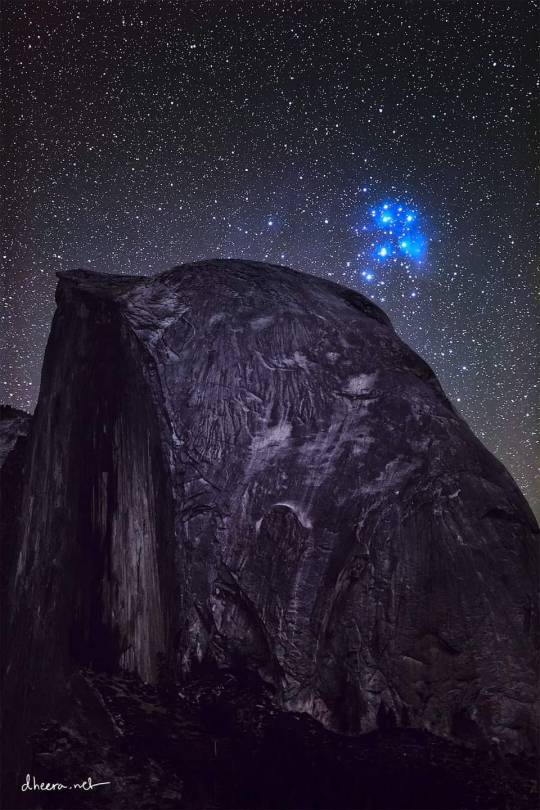
Pleiades over Half Dome Stars come in bunches. The most famous bunch of stars on the sky is the Pleiades, a bright cluster that can be easily seen with the unaided eye. The Pleiades lies only about 450 light years away, formed about 100 million years ago, and will likely last about another 250 million years. Our Sun was likely born in a star cluster, but now, being about 4.5 billion years old, its stellar birth companions have long since dispersed. The Pleiades star cluster is pictured over Half Dome, a famous rock structure in Yosemite National Park in California, USA. The featured image is a composite of 28 foreground exposures and 174 images of the stellar background, all taken from the same location and by the same camera on the same night in October 2019. After calculating the timing of a future juxtaposition of the Pleiades and Half Dome, the astrophotrographer was unexpectedly rewarded by an electrical blackout, making the background sky unusually dark. https://ift.tt/rj5BVkX
16 notes
·
View notes
Text
Five Things You Never Get Tired of Writing — Songs Edition
I did this one as a general "5 things I Never Get Tired of Writing" post already, but @autisticempathydaemon tagged me for songs specifically and I thought that was kinda cool so...
1. Fun Stuff for Villains
Because I love me some juxtaposition. And I was raised on Disney and the Muppets and sometimes a bad guy just needs a song.
Villain Song Count: 21
A select sampling:
Moore than the Average Mortal Man
Welcome to Wonderworld (Adam)
The House Always Wins (Imperium Sofia)
2. Quick Turnover for a Whole-Ass Gutwrencher
a.k.a. Erik works hard but Frenchie’s always on his heels. (j kidding)
It’s just that, like many fic writers, I get seized by the urge to write the thing as soon as I’m inspired. So a few of my favorites have actually been things I finished within hours of the Redacted content that inspired it.
Lighter than Air
Hey Buddy
Hoodie Song
End of the Earth (Hey Buddy Imperium Reprise)
3. Lullabies
My first song was a lullaby. Jess was the initial inspiration. It's a fun little genre, and it's sometimes my favorite thing to do a lullaby when it's totally inappropriate for the situation (i.e. here come some more villain songs hehehehehe).
Lullaby Song Count: 12
Sleep Tight (Vega's Lullaby)
A Little Drizzle of Blake Syrup
A Lullaby from the Desk of President Moore
Power Down (Aaron's Lullaby)
4. Cheesy, spur-of-the-moment shit
I sometimes write songs in under 30 minutes, but these don’t always get posted publicly. Often I just share them in a private server and they’re a response to some art or an inside joke.
One of my very first songs qualifies as this category (although I’d say it’s solid gold).
Pocket Caelum Suite
Tooth Fairy Song
Hero of the Purge
5. Challenge Pieces
There are a few things that have been a lot of work for me on a composition level and/or production level. These are the ones that may not necessarily be the “favorites” but they’re the ones I’m most proud of because I had to push myself. I don’t have much formal music education (just a lot of experience). And I definitely don’t know wtf I’m doing in GarageBand. So the fact that any of this has been worth posting on the internets is a small miracle.
Song for a Young Steward
Powerless (**This is the prettiest shit I've ever done.**)
By the Lights
Inversion Rap (Summarize 1 month of content in 6 minutes? Yes I did)
Not pictured: Content that isn’t Redacted fan art. I’m having a hard time getting up the nerve to post the stuff I have on deck I think.
#five things#redacted fanfic#redacted music#redacted fanart#redacted imperium#redactedverse#frenchie writes stuff#frenchie makes music#fan art music is its own thing#square peg in a round hole
6 notes
·
View notes
Photo
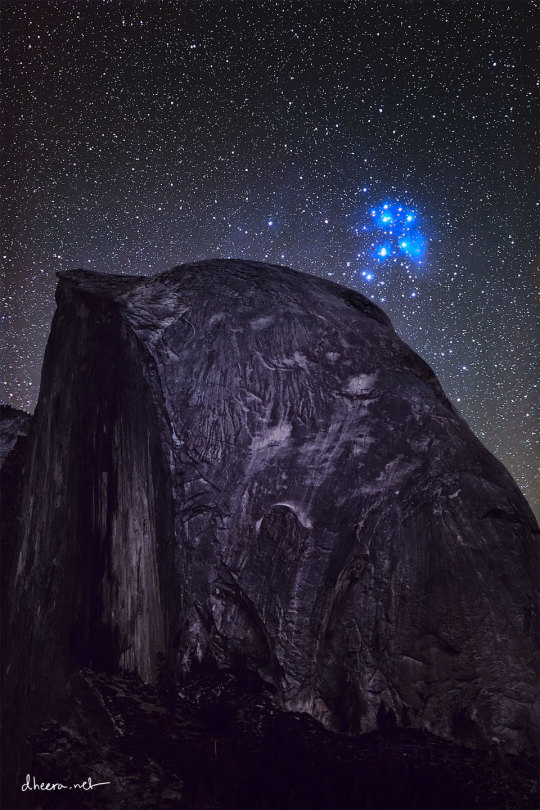
Pleiades over Half Dome - Dheera Venkatraman
Stars come in bunches. The most famous bunch of stars on the sky is the Pleiades, a bright cluster that can be easily seen with the unaided eye. The Pleiades lies only about 450 light years away, formed about 100 million years ago, and will likely last about another 250 million years. Our Sun was likely born in a star cluster, but now, being about 4.5 billion years old, its stellar birth companions have long since dispersed. The Pleiades star cluster is pictured over Half Dome, a famous rock structure in Yosemite National Park in California, USA. The featured image is a composite of 28 foreground exposures and 174 images of the stellar background, all taken from the same location and by the same camera on the same night in October 2019. After calculating the timing of a future juxtaposition of the Pleiades and Half Dome, the astrophotrographer was unexpectedly rewarded by an electrical blackout, making the background sky unusually dark.
2 notes
·
View notes